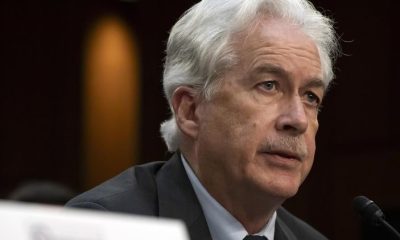Economy
N.S. agreements aim for balance on ecological forestry, economy
The Nova Scotia government says renewed agreements with Port Hawkesbury Paper will be good for the forests — and the economy — and take significant steps toward implementation of the 2018 Lahey Report that called for a shift to ecological forestry.
Under the agreements, the province has reduced the amount of timber the company can take from Crown land, while increasing the amount it will pay for management of public and private forests.
Natural Resources and Renewables Minister Tory Rushton says the agreements strike a good balance.
“This was something that we agreed in the terms of it that there’s prosperity for the company, there’s sustainability for the province and it still allows us to meet our targets and goals with the Lahey review,” he said.
Port Hawkesbury Paper agrees with the changes, which have become necessary as the business model for forestry has changed in the province, said Geoff Clarke, the company’s manager of business development.
Under its forest utilization licence, the paper company can harvest up to 275,000 tonnes of timber annually from Crown lands, which is down from 400,000 tonnes.

Taking less Crown timber will mean a shift to the private sector, he said.
“It’s the way it has to be,” Clarke said. “It’s part of the premise to look more towards the private lands to make up the difference of the drop in the allowable harvest off of Crown land.
“It shouldn’t have an impact on the amount of fibre that’s available.”
In addition, with the closure of Northern Pulp, more wood waste has become available to Port Hawkesbury Paper.
The Strait-area mill used to get five per cent of its supply from sawmill residue, but that has jumped to 40 per cent now, Clarke said.
“The model changes and we evolve along with it.”
Under the company’s separate fee-for-service agreement, Port Hawkesbury Paper will be paid $5 million a year to support sustainable forestry management on Crown and private lands.
Fees will help with ecological forestry training
That’s up from $3.8 million, which the province says will cover inflation and an increased focus on ecological forestry.
Clarke said the increased fees will go — in part — towards training and educating private woodlot owners on sustainable ecological practices.
For example, he said, in some cases cutting operations will leave more trees standing.
Raymond Plourde, senior wilderness co-ordinator for the Ecology Action Centre, said he is pleased with the announcements.
Taking less timber from Crown lands was a key recommendation of the 2018 report authored by University of King’s College president William Lahey.
“This is a very positive thing and it responds directly to the implementation of the Lahey Report,” Plourde said.
“Also a good thing is that the company itself is being progressive and is working with government and not fighting this, but rather doing what Professor Lahey recommended.”
Rushton said the agreements follow the full implementation of the so-called triad model of forest management recommended by Lahey.

The first part of the triad, called the conservation zone, exempts 35 per cent of Crown lands from forestry, including old-growth forests, parks and protected areas.
The second was introduced last year involving new guidelines for mixed-use forests representing 55 per cent of Crown lands, which are mostly Acadian forests on the mainland.
In that zone, new and previously approved harvest plans must follow low-intensity practices that prioritize biodiversity.
Rushton said Port Hawkesbury Paper is also launching a pilot project to apply new silviculture guidelines in mixed-use boreal forests in Cape Breton.
‘Still work left to do’
And last month, the province approved the third part of the triad by announcing a high-production zone will make up 10 per cent of Crown lands where clear-cutting will be allowed, but the contractor has to improve the soil afterwards and replant the area.
“We’ve achieved a lot in the last year,” said Rushton. “There’s still a lot of work left to do … and we’re still committed to making the steps forward to achieving those goals.”

Economy
The real problem with China’s economy – The Economist
[unable to retrieve full-text content]
The real problem with China’s economy The Economist

Source link
Economy
ECB Is Poised to Cut Rates Again in Warm-Up Act for the Fed – BNN Bloomberg
[unable to retrieve full-text content]
ECB Is Poised to Cut Rates Again in Warm-Up Act for the Fed BNN Bloomberg

Source link
Economy
Charting the Global Economy: US Job Growth Softer Than Forecast – Bloomberg
[unable to retrieve full-text content]
Charting the Global Economy: US Job Growth Softer Than Forecast Bloomberg

Source link
-

 Sports23 hours ago
Sports23 hours agoWilliam Stanback steps up in Montreal return as Lions beat Alouettes
-

 Health22 hours ago
Health22 hours agoHeal Your Dog Naturally
-

 News8 hours ago
News8 hours agoEnvironment solution: New metals refinery for nickel and cobalt opens in Ohio
-

 News8 hours ago
News8 hours ago‘Unstoppable’ captures Anthony Robles’ singular life, with Robles as his own stunt double
-

 Health23 hours ago
Health23 hours agoIron Man Stamina
-

 Sports9 hours ago
Sports9 hours agoCanadian para paddler Brianna Hennessy earns Paralympic silver medal
-

 News7 hours ago
News7 hours agoUS believes Iran has transferred short-range ballistic missiles to Russia
-

 News6 hours ago
News6 hours agoVenezuela revokes Brazil’s custody of diplomatic mission that’s housing 6 Maduro opponents




















